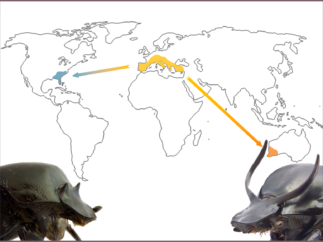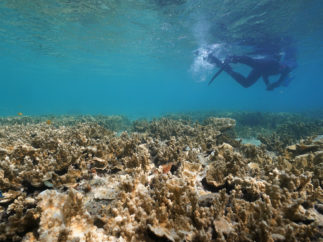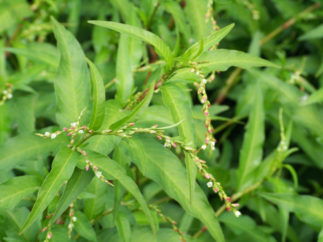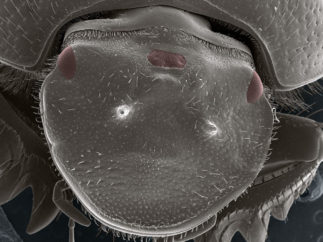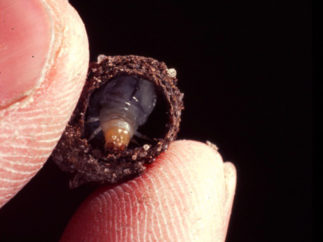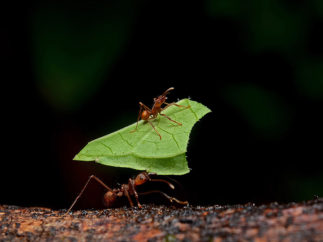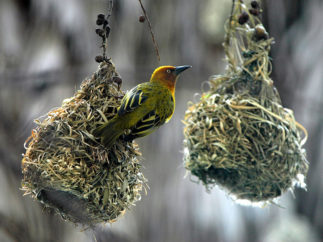While the climate is changing in complex patterns around our planet, there is strong consensus that global average temperatures are rapidly on the rise. Global climate change forces organisms to either cope with changing temperature regimes in their native habitats, or to face extinction. Furthermore, the resulting environmental changes can cause many areas to become suitable for non-native species, and the arrival of invading species can have significant impact on the already struggling natives. Successful establishment of alien species, which can drastically alter biodiversity, depends in part on the ability of each species to cope with new thermal environments. Therefore, determining if and how organisms can adapt to changes in temperature is critical to forecast the impact on populations of a globally changing climate, as well as to predict the risk and potential outcomes of biological invasions.
Rapid evolution and phenotypic plasticity: insights from horned beetles
All organisms face the challenge of having to cope with variable environments. Diverse factors, from food and water availability to temperature, predation pressures, or conspecific densities, may impact an organism’s development, survival, and reproduction. Phenotypic plasticity is one mechanism that allows individuals to cope with variable environmental conditions within their life time, and most organisms therefore exhibit some form of phenotypic plasticity at least at some point during their development in one or more traits.
Coral reefs and niche construction: quantifying patterns
Coral reefs are one of the most biodiverse and threatened ecosystems in the world. Scleractinian corals act as ecosystem engineers and build the three-dimensional framework that provides shelter and food for themselves and all the other species that inhabit the reef. They are characterised by high diversity in terms of species, growth forms and demographic rates, harbouring one third of known marine fish species in less than 1% of the oceans’ surface.1
Getting into the weeds: Individual plasticity and adaptive variation
Starting with Watson and Crick, genes have been defined as stretches of the DNA molecule that contain developmental instructions for particular traits; evolutionary biologists consider genotypic variations to be the source of the differences among individual organisms that result in natural selection. Yet this elegantly simple view of adaptive evolution overlooks the fact that environmental conditions also play a role in development. After decades of focusing on genes as self-contained developmental instructions, the newly emergent discipline of ecological development (eco-devo)1, 2 represents a return to an earlier, more holistic perspective that promises to change our understanding of adaptive variation and evolution.
The holobiont as a unit of selection
In our recent paper published in Biological Theory, we present compelling evidence that the holobiont is a unit of evolutionary selection, and we propose a new mathematical model to help us understand its evolution. But first, what is a holobiont? A holobiont is a large organism (a “macrobiont,” such as an animal, fungus, or plant) together with its microbiome. We define the latter as “a microbial biome closely associated with a living host.” In other words, microbes that interact with a host transiently are not included in the host’s microbiome, while even pathogenic microbes that stably associate with a host are included. The hologenome is the sum of all the genes of the host and all its symbionts (microbes that constitute the microbiome). According to the hologenome concept of evolution, the holobiont and its hologenome constitute a unit of selection; but this concept is disputed and the body of literature dealing with holobiont evolution and selection is quite small. Two major criticisms of the hologenome concept of evolution have been that microbiomes may not be highly conserved enough across generations to contribute to holobiont evolution, and that there is no mathematical model of holobiont evolution. Here we address these criticisms.
What functional ectopic compound eyes can teach us about the role of context in development and evolution
Organisms are mosaics of diverse traits. Some of these, such as eyes, limbs, or light producing organs, attain a remarkable level of complexity: each is comprised of a large number of component parts that relate to each other through often intricate and precise interactions, most if not all of these being required for the trait as a whole to perform its function correctly. Complexity is a hallmark of living systems, and a source of beauty and wonder for those who study it.
Developmental niche construction in dung beetles
Understanding the extraordinary fit between organisms and their environments, or the nature of adaptation, is a long-standing focus of evolutionary biology. Traditionally, evolutionary biologists have focused on two routes to adaptation: organisms may adjust their phenotypes developmentally during their lifetimes through phenotypic plasticity, or across generations through evolved genetic changes in phenotype expression. A growing body of work suggests, however, that a third route may be similarly important. Here, rather than adjusting their traits to suit environmental challenges, organisms systematically modify their environment to suit their traits – a process known as niche construction.
How do living beings fulfil the conditions for evolution by natural selection?
Have you ever wondered why there is such intense disagreement over the evolutionary significance of niche construction? If so, you may be helped by a recent paper in the British Journal for the Philosophy of Science. The paper shows how contention arises from alternative assumptions regarding the causal independence of the processes that generate variation, differential fitness, and inheritance.
Deconstructing niche construction: A TVOL conversation between Gordon Burghardt and Kevin Laland
The concept of niche construction stresses a dialectical relationship between organisms and their environments, rather than one being passively shaped by the other. It has deep roots in evolutionary thought but only now is resulting in a systematic research program as part of the Extended Evolutionary Synthesis (EES). Join Gordon Burghardt and Kevin Laland as they take a deep dive into the subject.
Workshop report: Cause and Process in Evolution
“Most scientific explanations are causal. This is also the case in evolutionary biology, where the primary goals are to explain the diversity of life and the adaptive fit between organisms and their surroundings. Yet, the nature of causation in evolutionary biology is contentious.” So starts the description of a workshop on Cause and Process in Evolution, organized by Kevin Laland and Tobias Uller. It brought together an eclectic mix of evolutionary biologists, developmental biologists, and philosophers of biology, with the aim of addressing this contention. I sat in on this workshop, like a fly on the wall, in the hope of learning a bit about the latest research and debates in evolutionary biology.

